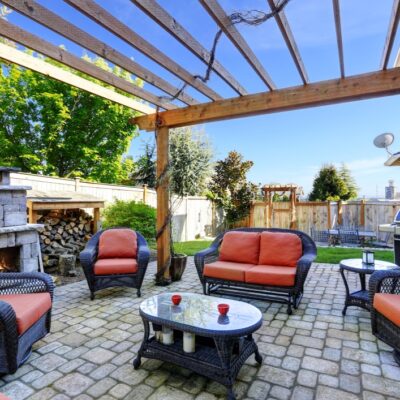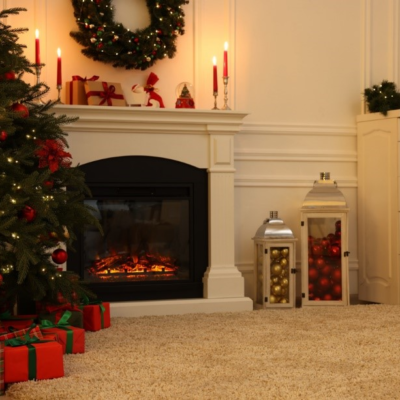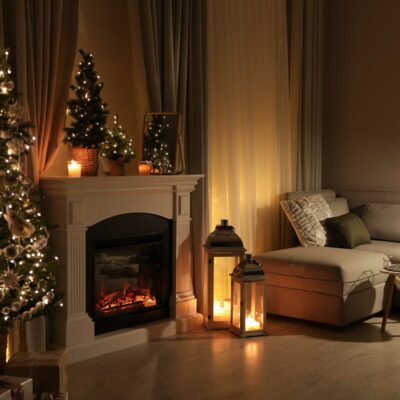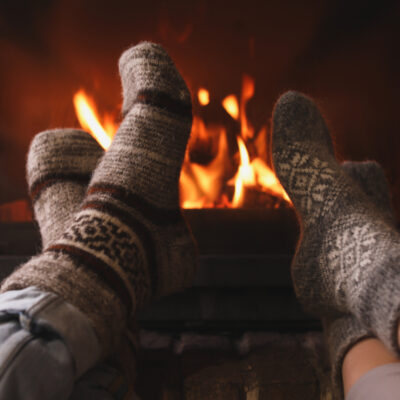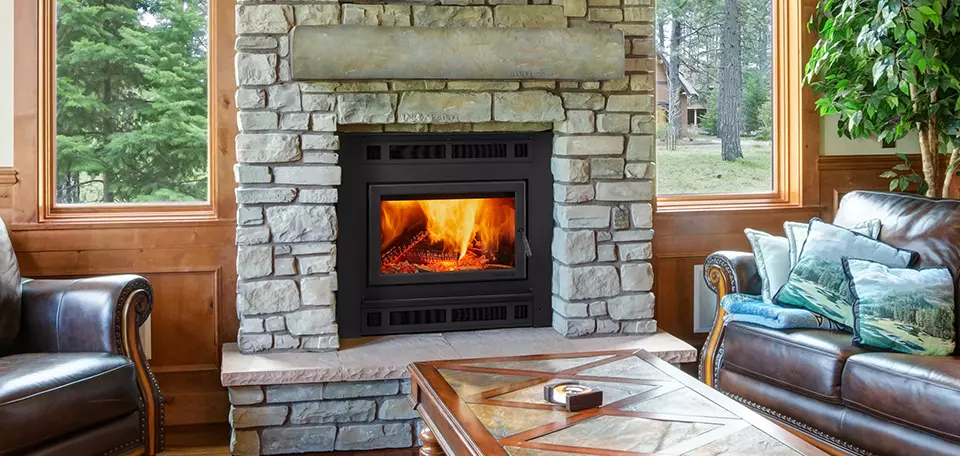
There’s nothing better than cozying up next to a blazing fire and relaxing during the colder months. Wood-burning fireplaces may be the age-old standard, but they are quickly losing their popularity to gas fireplaces. Unlike wood-burning fireplaces, gas fireplaces do not come with the extra hassle of chopping and hauling firewood, making them a great heating source for homeowners who prefer less maintenance.
When you start shopping for a new fireplace, you will quickly discover that there are two main categories of gas fireplaces: direct vent and vent-free. Both types come with their own set of pros and cons, which can make the decision-making process overwhelming. But don’t worry!
With years of experience helping Hoosier homeowners with their hearths, our team at Godby Hearth & Home knows a thing or two about fireplaces. When debating between a direct vent or ventless gas fireplace, there are a few important facts and considerations to keep in mind.
What are vent-free fireplaces?
The biggest difference between direct vent and vent-free gas fireplaces, as inferred by their names, is the venting system. Ventless fireplaces do not require a vent pipe and are often purchased by homeowners who want their fireplace in a specific area of the home where venting is nearly impossible. The burner in a ventless gas fireplace is extremely efficient and can be installed in your existing wood burning fireplace inside your home.
Recommendations for Ventless Gas Fireplaces
Modern Linear Fireplace
A modern linear ventless fireplace is perfect for those seeking a sleek and contemporary design. This type of fireplace offers:
- Energy-Efficient Zone Heating: Keep your energy bills low while maintaining comfort.
- Programmable Control: Tailor the flame and heat settings to match your preferences.
- Remote and LED Control: Manage everything with ease from the comfort of your seat.
Additionally, the intermittent pilot ignition helps save energy, and a battery backup ensures the system continues to operate during power outages.
Traditional Brick Firebox
For those who prefer a classic look, consider a traditional brick vent-free firebox. This option mimics the ambiance of a natural wood-burning fireplace and includes:
- Multiple Log Set Configurations: Customize the look with various options to fit your style.
- Optional Interior Liners: Choose from different liners to match your interior decor.
- Flush Hearth and Hideaway Screens: Enhance the fireplace’s natural look while maintaining safety.
An extra-tall opening also improves heat distribution, ensuring your space stays warm and cozy.
These recommendations cater to different styles and needs, offering both modern and traditional options for ventless gas fireplaces. Choose the one that best fits your home and enjoy efficient, customized heating.
What are direct vent fireplaces?
Unlike a vent-free gas fireplace, a direct vent gas fireplace has a sealed glass panel and venting system. A vented gas fireplace pulls air from the outside into the fireplace and then expels exhaust back outside through a separate pipe, Direct vent units can also be installed in your existing wood burning fireplace inside your home.
When choosing a direct vent gas fireplace, there are a few standout options that combine aesthetics, efficiency, and safety features.
1. Elegant Direct Vent Fireplace
This fireplace is ideal if you want a mix of modern design and robust performance. It features a high-efficiency burner that produces tall, mesmerizing flames. The unit comes with an easy-to-use touchscreen remote control, allowing you to adjust settings effortlessly. Safety is a top priority, with ceramic glass that enhances heat transfer while providing a barrier between you and the flames.
2. Advanced Heat Redirection Fireplace
For those who desire more control over how heat is distributed in their home, this fireplace includes a unique heat redirection system. This feature allows you to channel warmth to specific rooms, improving overall energy efficiency. The combination of direct vent technology and an intuitive app for remote operation makes this fireplace a versatile and convenient heating solution.
3. Customizable Direct Vent Gas Fireplace
If customization is what you seek, this option offers various design choices to fit any decor. From multiple trim and surround finishes to a selection of interior panel designs, you can tailor this fireplace to your exact preferences. The direct vent system ensures that combustion exhaust is safely removed, while optional add-ons like a blower kit enhance heat dissemination throughout your space.
Features to Look For
When evaluating direct vent gas fireplaces, consider the following features:
- Touchscreen Remote Control: For easy operation.
- Heat-Zone Technology: To direct warmth to specific areas in your home.
- Ceramic Glass: Enhances safety and heat transfer.
- App Compatibility: For remote adjustments and monitoring.
These features not only improve functionality but also add a layer of convenience and safety to your heating system.
Selecting the right direct vent gas fireplace hinges on your specific needs and preferences. Whether it’s high aesthetic value, advanced heat redirection, or extensive customization options, there’s a direct vent gas fireplace out there that will perfectly suit your home environment.
By focusing on well-rounded details and a variety of features, this guide helps you make an informed decision tailored to your heating requirements.
What are the advantages and disadvantages of vent-free?
One of the biggest arguments in the direct vent vs. vent-free gas fireplace discussion is efficiency. While both systems are efficient, vent-free gas fireplaces are significantly more efficient and have a greater heat output. Ventless gas logs can also be used when the damper is closed, resulting in more heat staying inside of your home instead of slipping out through the flue.
However, most vent-free fireplaces are less realistic in appearance. Some localities have codes and regulations in place that limit or ban the use of vent-free fireplaces. There are strict rules for installing ventless gas fireplaces in bathrooms or bedrooms, including limits on how many BTUs are allowed. Vent-free gas fireplaces also have significant clearance requirements that apply to the areas above and around the fireplace.
Ventless fireplaces must have built-in oxygen depletion sensors (ODS) to confirm safe operation by shutting off the fireplace if oxygen levels drop below a safe threshold.
However, ventless fireplaces can potentially impact indoor air quality, leading to increased levels of moisture and combustion byproducts like carbon monoxide. It is crucial to use them in well-ventilated spaces and follow all safety guidelines, such as installing carbon monoxide detectors and ensuring regular maintenance.
What are the advantages and disadvantages of direct vent?
Unlike their vent-free counterpart, direct vent gas fireplaces are typically more realistic and have a better flame presentation. Direct vent fireplaces offer a range of safety features that make them a top choice for home heating. These fireplaces are sealed systems, preventing indoor air pollution and reducing the risk of carbon monoxide poisoning. Additionally, direct vent models have valves that control the gas flow, ensuring the gas turns off if the pilot light goes out.
Moreover, direct vent fireplaces do not emit odors, soot, or moisture into the room. This makes them an excellent option for those who have an increased sensitivity to odors or suffer from allergies or asthma.
For added peace of mind, ventless fireplaces are equipped with built-in oxygen depletion sensors (ODS). These sensors confirm safe operation by shutting off the fireplace if oxygen levels drop below a safe threshold. This comparison highlights the robust safety mechanisms that make direct vent fireplaces a secure and reliable choice for any home.
Another key difference between direct vent and ventless gas fireplaces is design. Direct vent fireplaces have many different sizes and shapes, media options, frame styles and frame finishes available to create a truly custom look and feel that matches your unique aesthetic. However, direct vent gas fireplaces typically cost more than vent-free fireplaces and require careful installation to ensure the venting process works seamlessly.
Installation and Maintenance Requirements for Direct Vent and Ventless Gas Fireplaces
When considering gas fireplaces, understanding the installation and maintenance requirements for both direct vent and ventless models is crucial.
Installation
Direct Vent Fireplaces:
- Requirements: For a direct vent fireplace, you’ll need access to an external wall or roof for venting. This necessity can add to installation costs and complexity.
- Sealing and Venting: Proper sealing and venting are essential to ensure safety and efficiency. Failing to do so can lead to dangerous leaks or inefficient performance.
Ventless Fireplaces:
- Flexibility: Ventless fireplaces offer greater flexibility since they don’t require external venting. You can install them in a variety of locations within your home.
- Cost and Simplicity: The absence of venting components simplifies the installation process and can significantly reduce costs.
Maintenance
Direct Vent Fireplaces:
- Venting System Checks: Regular maintenance is crucial, including checks of the venting system to guarantee it’s free of blockages and seals remain intact.
- Professional Inspection: An annual professional inspection is recommended to ensure safe and efficient operation.
Ventless Fireplaces:
- Combustion and Air Quality: Since ventless models operate without external vents, routine checks to ensure safe combustion and monitor indoor air quality are necessary.
- Annual Check-Up: Similar to direct vent models, ventless fireplaces should also undergo an annual inspection by a professional to maintain optimal safety and performance.
Both fireplace types offer distinctive installation and maintenance needs. Understanding these requirements can help you make an informed choice suited to your home’s specifications and your maintenance preferences.
Is your mind made up? Need additional information?
Godby Hearth & Home is proud to be Indiana’s choice for fireplace installation and servicing. We have served thousands of homeowners with their fireplace needs and would love to help install a gas fireplace that you will love for years to come!
If you still can’t choose, we would be happy to discuss direct vent vs. vent-free fireplaces with you and help you choose the best system for your home. Feel free to give us a call or visit us at our showroom to browse our options and learn how we can help you enhance your fireside experience.

